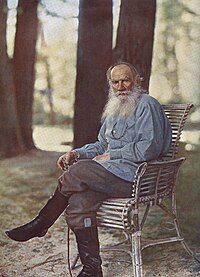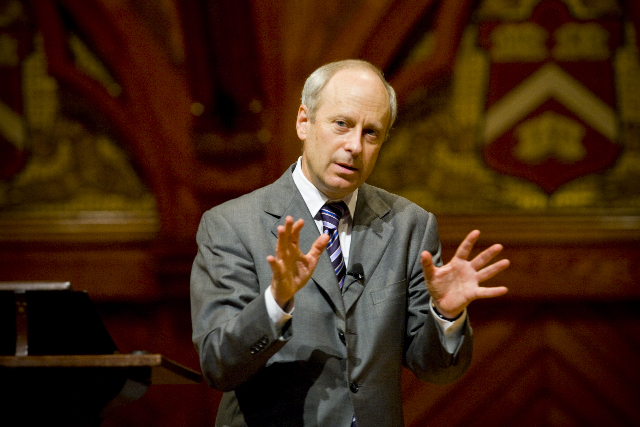I finished reading
Anna Karenina the other day, and I was struck by how much Tolstoy’s writing reminded me of Jane Austen’s, even though some five decades separated their novels and they literally lived worlds apart. Of course, I realize that there are stark differences between the two: Austen’s airy neoclassical style strives for syntactical perfection, balance, indirection and wit, and it swims with parallelism and antithesis, subordinate clauses and parentheticals, understatement and irony; Tolstoy’s heavier and unironic (transcendental?) realism purposely lacks perfect syntactical form and strives for clarity and directness with emphasis on independent clauses and simplicity rather than subordinates; Austen utilizes third-person limited narration with its primary focus on her main characters: Lizzy, Emma, Marianne, Anne Elliot, etc., while Anna Karenina possibly best exemplifies third-person omniscience as the narration shifts from the interior and exterior perspectives of all seven major characters (Oblonsky, Darya, Anna, Karenin, Vronsky, Levin, and Kitty) and occasionally some minor ones like Levin’s brother and Countess Lydia Ivanovna; Austen rarely if ever alludes to or quotes from the Bible or literature, but Tolstoy makes constant literary and Biblical allusions; and while Austen is sometimes criticized for her dearth of major political events and philosophical ideas of her day (there’s nothing in Austen about the American Revolution, Napoleon, or Romanticism—all of which occurred during her lifetime), Tolstoy’s characters discuss the socio-political and philosophical issues of his day: liberalism, agrarian reform, the role of peasants in Russian society, educational reform, and women’s rights. Austen would never describe a nursing baby latching on to his mother, a Dickensian tenement occupied by a frail and dying man suffering from bedsores, or a violent death by train with its bloody remains. Not that Tolstoy elaborates on the graphic or the sexual, and there are certainly no descriptions of the sex act in Anna Karenina, but while it’s clear in Austen that characters have extramarital relations, she writes about infidelities and other scandals with such restraint and indirectness that make it seem unfathomable that sex, poverty, or squalor exist in her world.

Even though at the syntactical level we see differences between Austen and Tolstoy, in general terms I think most people would put them both in the realist camp. Tolstoy is a more “serious” realist than Austen and in terms of content Austen is a bit of a romantic, but neither of them uses the kind of entertaining but sometimes absurd Dickensian plots or characters; in Austen and Tolstoy, there are no gothic elements, no ghosts, no monsters raised from the dead—all aspects common in the greatest 19th century literature. Austen’s style mirrored a neoclassical realism that had nothing in common with the naturalism popular in modern novels, but she was still striving to paint a realistic picture of her era—at least in terms of capturing middle- and upper-class conversations. But to say that Austen and Tolstoy are realists is perhaps a bit misleading because there is also a clear sense of morality or even spirituality in them. Transcendental realism sounds oxymoronic and I’m not sure that term quite applies to Austen, but in general terms both authors are interested in demonstrating the contentment and spirituality that comes with inner peace. While we don’t get anything quite like Levin’s moments of spirituality and peace while working the fields or observing peasants when reading Jane Austen, her characters do find in the end a happiness that might be equated to spirituality.
In reading and teaching Pride and Prejudice a number of times over the years, I have come to the conclusion that Austen subtly satirizes the Church. She clearly uses vapid characters like Collins to criticize traditional Christianity—or, more specifically, Christians by name and not by deed. Collins is the only spiritual leader in the novel, yet he is also one of the most unforgiving and judgmental—think about his letter to Mr. Bennet in which he says that the “death of your daughter would have been a blessing in comparison” to her running away with Wickham and then harshly advises him “to throw off your unworthy child from your affection for ever, and leave her to reap the fruits of her own heinous offence.” In his own life Tolstoy was a Christian anarchist, a man who criticized the state church, preached pacifism, advocated asceticism (including abstaining from sexual relations), and believed that happiness comes from modeling one’s life on the teachings of Jesus and not the ritual and liturgical practices that accompanied the state church. Being a Christian for Tolstoy meant something more than attending mass or confessing one’s sins a few times a year. To my knowledge we don’t know the details of Austen’s religious beliefs but I wouldn’t be surprised if she agreed with the Russian.
Stylistically, another key similarity between Austen and Tolstoy is that both utilize imprecise character descriptions. For example, Austen’s first description of Darcy in Pride and Prejudice occurs during the Lucas’s ball: “Mr. Darcy soon drew the attention of the room by his fine, tall person, handsome features, noble mien.” This kind of vague physical detail is common in Austen. Aside from a handful of references to Elizabeth’s “dark eyes,” Austen never provides a physical description of her main character Elizabeth; instead, she describes general personality traits and says that Lizzy “had a lively, playful disposition, which delighted in any thing ridiculous.” Even when Elizabeth’s biased mother Mrs. Bennet describes her daughter, it is in imprecise terms: “Lizzy is not a bit better than the others; and I am sure she is not half so handsome as Jane, nor half so good humoured as Lydia.” And when the narrator first describes Mr. and Mrs. Bennet in perfect parallelism, again we see imprecision at work: “Mr. Bennet was so odd a mixture of quick parts, sarcastic humour, reserve, and caprice, that the experience of three and twenty years had been insufficient to make his wife understand his character. Her mind was less difficult to develope. She was a woman of mean understanding, little information, and uncertain temper. When she was discontented, she fancied herself nervous. The business of her life was to get her daughters married; its solace was visiting and news.”
It’s true that Tolstoy doesn’t go as far as Austen in this regard, but they are kindred spirits when it comes to vague descriptions. The only character details we get about Oblonsky at the beginning of
Anna Karenina are that he is 34, “handsome” and “amorous.” While Tolstoy shows Levin blushing occasionally, he doesn’t tell us what Levin looks like. However, Tolstoy does often go into more detail when describing his female characters, especially in terms of hairstyle, attire, and dress. For instance, when we are first introduced to Darya, she is “wearing a dressing jacket, the skimpy braids of her once thick and beautiful hair pinned at the back of her dead, her face pinched and thin, her big, frightened eyes protruding on account of that thinness.” But even though Tolstoy will eventually describe Anna’s clothing and some of her physical traits, the first description of Anna, as Vronsky meets her on the train, is Austenesque: “Vronsky determined from one glance at this lady’s appearance that she belonged to high society…[he] felt a need to glance at her once more—not because she was very beautiful, not because of the elegance and modest grace that could be seen in her whole figure, but because there was something especially gentle and tender in the expression of her sweet-looking face.” (Interestingly, this particular sentence contradicts what I said earlier about Tolstoy in general; this one is syntactically Austenesque in its use of subordinate clauses and parallelism). It’s true that in the next sentence Vronksy recognizes Anna’s “shining grey eyes” and “thick lashes,” and though Austen would probably never describe a character’s eyelashes, we can see from this passage that Tolstoy, like Austen, purposely omits physical details in his main characters. Preferring the vague over the precise, both authors use words like beautiful and handsome in order to create a blank slate for the reader to fill in the gaps. Beauty is somewhat subjective and in not spelling out what it means for them, we can envision our own characters, making the reader an active participant in the construction of the novel.
Another important similarity between Austen and Tolstoy is that both tend to downplay the physical environment and focus their narration on dialogue and character’s thoughts. Austen only rarely describes the countryside. For instance, in
Pride and Prejudice, the only time the landscape is described (from what I recall) occurs in the few pages of description of the grounds at Pemberley, which is used by Austen not to reflect on nature or the environment but to provide a metonym for Darcy’s character. In other words, Pemberley and its grounds represent the stability, traditions, and nobility of Darcy. Tolstoy does spend more time describing the country than Austen, but like Austen he uses these descriptions primarily to comment upon Levin’s character (he is also interested in making a few salient socio-political comments about land reform and the peasantry). Perhaps the greatest affinity between these great 19th- century authors is the emphasis on dialogue and interior reflections. Authors use many different ways to communicate information about their characters. Some use physical description, some dialogue, some actions, some the landscape. Austen probably utilizes more dialogue than Tolstoy, who more heavily utilizes interior narration, and the kinds of topics that characters discuss and the manner in which they discuss these topics are somewhat different. Striving primarily for humor and wit, Austen fills her novels with both clever and stupid people to make the reader laugh; Tolstoy’s characters are much more occupied by weightier philosophical conversations—at least at times. The emphasis on dialogue and interior reflection impacts the depth and complexity of our understanding of their characters. We thoroughly understand Lizzy, Anne, Emma and other Austen characters because we have been inside their heads for the majority of several hundred pages, and the same is true for Levin, Anna and the other major Tolstoy characters. We know not only what they say but how they think and why they think in this particular way.
However, now that I think about it, another fairly significant difference is Austen’s heavy use of foils. Nearly everyone in an Austen novel contrasts with a major character in some way. In
Sense and Sensibility we have Marianne and Elinor, in
Emma, there is Mr. Knightly and Mr. Churchill, and in
Pride and Prejudice Elizabeth’s foils include Mr. Bennet, Lydia, Jane, and Charlotte. Austen uses these contrasts to shed light on her main characters; in other words, we learn more about Lizzy by observing Lydia and Charlotte. There are of course contrasting characters in Tolstoy: characters who have affairs (Oblonsky and Anna), characters who deal with their spouse’s infidelity in different ways (Karenin and Darya), and the radically contrasting brothers of Levin. But I wouldn’t call any of these foils—a foil is something more than a contrasting character.
On a plot level, both Austen and Anna Karenina deal with the impact, resolution, and return of a rejected suitor. In
Pride and Prejudice we have Darcy, in
Persuasion, Anne Elliot, in
Anna, both Levin and Vronsky. Though their characters are decidedly different (Darcy is the embodiment of pride, Levin is the embodiment of reason and humility, and Vronsky is somewhere between them) and Austen’s arc is much more dramatic in terms of the changes that occur because of the rejection (at least this is true for Darcy), this basic theme does tie the woks together nicely.
I’m sure there are other differences and similarities, and I recognize the dearth of examples here. In fact, if I was grading this, I would write “more textual support needed.” Then again, this isn’t meant to be a high school term paper.










